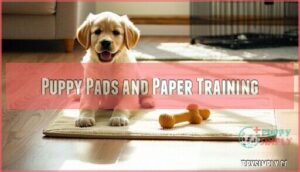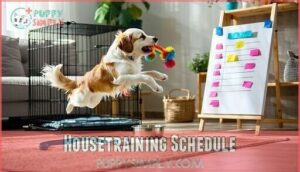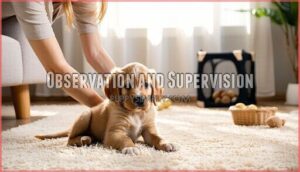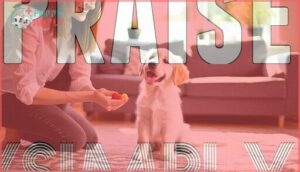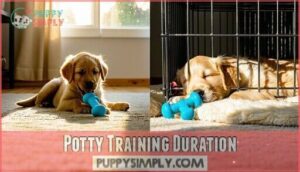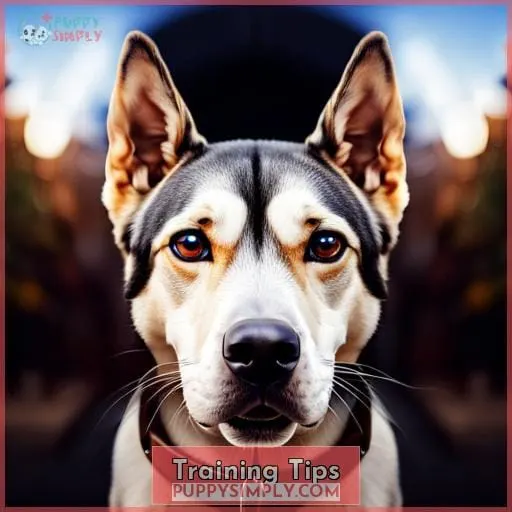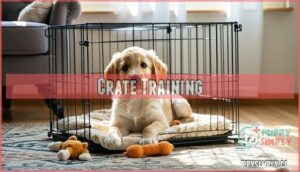This site is supported by our readers. We may earn a commission, at no cost to you, if you purchase through links.
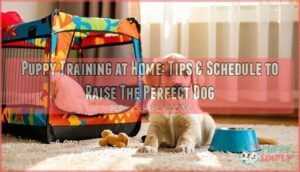 Bringing home a puppy is an exciting time, but it can also be quite daunting. Training your pup correctly from the start is essential for having a well-behaved dog in the future.
Bringing home a puppy is an exciting time, but it can also be quite daunting. Training your pup correctly from the start is essential for having a well-behaved dog in the future.
Here we will provide useful advice on how to crate train your puppy, introduce potty pads and paper training, create a housetraining schedule, and solve any problems that may arise along the way.
Table Of Contents
Key Takeaways
- Crate training is essential for establishing a routine and preventing accidents.
- Use positive reinforcement, such as treats and toys, to associate the crate with positive feelings.
- Establish a consistent house training schedule and observe potty habits to understand signals.
- Provide chew toys and discourage destructive behavior to prevent chewing on furniture.
Crate Training
Crate training your pup is an important step in establishing a regular and comfortable routine at home. It allows them to have their own space for security and prevents accidents. To create the perfect crate experience for your pet, start by getting the right size of dog crates.
Choose one that will give them enough room to stand up, turn around, and lie down. Having a little canine cave they feel safe in helps build confidence and teaches good habits from day one.
When introducing puppies to their crates, use treats or toys so they associate it with positive feelings instead of confinement. If needed, line puppy pads on the bottom. This way, potty training puppies at home is easier when living spaces are small or noisy environments make housebreaking difficult during the initial stages of learning new behaviors.
Avoid using punishment while teaching proper manners inside their den. Praise rewards more effectively than scolding! Finally, provide chew toys like Nylabones or Greenies dental chews. These help discourage destructive behavior like chewing furniture that could otherwise damage the true methods used in the housetraining process.
Puppy Pads and Paper Training
Using puppy pads and paper training can help make potty training easier in tight spaces or noisy environments. These methods provide an alternative to outdoor pottying, allowing puppies to learn the right place for their bathroom breaks while living indoors.
Here are some tips on how to get started:
- Utilize a crate when introducing your pup to housebreaking with puppy pads and paper. This will give them a secure den-like atmosphere, helping build confidence while teaching good habits from day one.
- Reward good behavior with treats or toys, so they associate it positively instead of feeling confined within the crate.
- Provide appropriate chew toys like Nylabones or Greenies dental chews as distractions that discourage destructive behavior like chewing furniture, which could otherwise damage housetraining efforts.
- Use piddle pads for accidents around the home; these reusable puppy pads absorb moisture better than newspaper does! It is also important not to scold but rather praise rewards more effectively during this process.
Finally, use positive reinforcement such as treats and verbal praise when using the right potty training supplies at home – this helps reinforce desired behaviors quickly and efficiently!
Housetraining Schedule
Creating a consistent housetraining schedule is essential for success, so your pup can quickly learn where their bathroom breaks should be taken. Establishing the right time to go outside and rewarding with positive reinforcement will help make it easier for them to transition into a house-trained puppy.
Additionally, adjusting diet and bladder control as well as taking frequent trips outside are important steps in keeping an indoor dog from having accidents inside the home.
| Consequences | Positive Reinforcement | Dr. Burch |
|---|---|---|
| Scolding | Treats & Praise | Dog Keeps $rightarrow$ Indoors Bathrooms |
Observation and Supervision
Observing and supervising your pup’s potty habits is key to understanding their individual signals and rhythms. A consistent crate timing, along with monitoring puppy habits such as scratching or sniffing, can provide clues for when it may be time for a bathroom break.
It’s important to adjust the dog’s diet according to its age and size in order to have better control over bladder capacity.
Lastly, being aware of early signs that tell if something isn’t quite right can assist with proper supervision tactics so that any potential issues are addressed before becoming out of hand.
Diet Control
Controlling your pup’s diet and feeding schedule is essential for successful potty training, much like planting a garden to grow fresh vegetables.
Mary Burch, an AKC-certified professional dog trainer and behavior consultant, suggests that if you have a 6-month-old pup or younger, it is best to feed the right size portions three times per day. This will help with regular trips outside as well as controlling your pup’s diet, allowing them to digest food in a shorter amount of time so they can go out more frequently when needed.
Additionally, providing appropriate chews during this time also helps by keeping their mouth busy while teaching them what items are okay to chew on instead of furniture or other objects around the house.
If there are any accidents inside, ensure you clean up quickly using an odor-removing cleaner, making sure all smells associated with peeing/pooping are gone from separate spots. This is to prevent puppies from repeating mistakes in those particular areas over long periods of time.
Praise
After you’ve controlled your pup’s diet and feeding schedule, it’s important to use positive reinforcement. Praise and encouragement will go a long way in helping puppies learn the house rules quickly.
When they do something right, tell them good boy or give them treats as rewards for their obedience training progress. Patience is also key. Playful puppies may take longer to grasp concepts than others due to their energy levels.
Redirection from inappropriate behavior can help too. Provide appropriate chew toys if chewing furniture should occur, reminding pups what items are okay to chew on. This helps prevent destructive behaviors. Independence plays an important role when leaving home as well.
Gradually increase time away from the pup to help them adjust better over time. Coddling them too much before going out might cause separation anxiety upon return home later on.
In order for successful puppy potty training at home, patience and consistency, coupled with proper reinforcements such as praise and redirection, go a long way in teaching good manners early on.
Housetraining Problems
If housetraining isn’t going as planned, it’s important to take a step back and assess the situation. Going back to square one with crate and house training may be necessary if accidents continue. A vet workup can also help determine if the puppy has any issues related to bladder or bowel control.
Old methods of punishment are ineffective when tackling potty-training issues. A stinky mess is not what you want your tiny dog associating with doing their business outdoors! Positive reinforcement, such as treats or verbal praise, will make for better success in teaching them where they should go each time.
The best approach is patience alongside consistency. This, coupled with rewards, will give puppies an understanding that using the bathroom outdoors is a good idea!
Potty Training Duration
Now that you understand the basics of housetraining, it’s time to discuss how long potty training will take. When it comes to puppy training at home, the duration can vary greatly depending on factors such as age and learning history.
Some puppies have perfect manners in a few days, while others may take months! Patience and persistence are key for successful potty training – not just for your pup but also for yourself.
Establishing crate expectations is important. Having an area they feel safe when left alone or during vet visits is essential.
Providing appropriate chew toys like Nylabones or Greenies will help reinforce rules about what’s okay to gnaw on versus furniture. Bitter no-chew spray can also be used if necessary too—just make sure you clean up after any accidents right away so your dog doesn’t associate their stool with positive reinforcement (like treats).
With consistency, time, attention, and effort from both owner and pup alike, success in puppy potty training isn’t out of reach—you’ve got this!
Training Tips
Taking on the challenge of puppy training at home can be daunting. However, with a few key tips and some patience, you can help your pup become an obedient member of the family in no time!
Start off by establishing crate expectations. This will give them security when left alone or during vet visits.
Then move onto teaching bathroom rules so there are fewer accidents inside the house.
Leash training is important for walks around town.
Socialization is crucial to build confidence and friendliness.
Teach your puppy to sit to prevent jumping.
Use no-bite techniques, such as yelping or ignoring, to discourage biting.
Also, discourage chewing on furniture.
With all these steps completed, you’ll have a great foundation for successful puppy potty training!
Crate Training
Crate training your pup is a great way to ensure they have a safe and comfortable space. Crate sizing, cleaning accidents, crate love, and control are key. Feeding in their crate helps them love it while teaching independence too! Different options exist for the ideal situation and diet; visit AKC for tips from the director.
Bathroom Rules
Establishing bathroom rules is an essential part of pup parenting, so take your time teaching them the ropes. Reward correct behavior and avoid scolding; clean up messes quickly, designate potty spots, and monitor bladder control.
Give the new pet a chew toy or dental chew stick; use a high-pitched voice when needed to stop biting.
Leash Training
Leash training your pup is a great way to keep them focused and ensure they stay on the right track. Use positive reinforcement, establish house rules, and take breaks during socialization outings for successful leash walking.
The training period should involve a minor form of attention withdrawal as a clever alternative to punishment.
Socialization
Socializing your pup is key: walks, pet stores, and positive reinforcement. Time commitment is essential – walking on a leash, playtime, and socialization.
Sitting
Teach pup to sit with positive reinforcement: treats, praise. Table highlights time away, appropriate chewing, and bitter no chew. Knowledgeable guidance for puppy training at home; common mistakes highlighted and next steps given! Care of a teething pup is vital for socialization success.
No-Bite
Firmly discourage biting with a loud, high-pitched voice and positive reinforcement.
Home Alone
Help your pup adjust to being home alone and gain independence by gradually increasing time away. Crate train, use no-chew spray, provide toys and food for comfort. Reward appropriate chewing with treats and praise; discourage bad habits! New dog owners should set a good goal: understanding their pet’s needs.
Chewing Furniture
Encourage appropriate chewing with toys and discourage furniture chewing for successful puppy training. Utilize preventative measures, a reward system, and positive reinforcement. Try no-chew spray or chew toys to keep clean creatures and have plenty of pet stain remover on hand! The best way is consistent praise when good behavior occurs.
Frequently Asked Questions (FAQs)
What type of rewards should I use for potty training?
Rewards for potty training your pup can include verbal praise, treats, and toys. Make sure to reward immediately after the desired behavior is exhibited in order to reinforce it.
How can I potty train my puppy if I work long hours?
Hire a dog walker or enlist the help of your family and friends to take care of potty breaks while you’re away. Create a housetraining schedule that works for you, providing plenty of opportunities for success.
Monitor closely when at home and reward positive behaviors with treats or praise–scolding will not be effective.
What can I do if my puppy has a urinary tract infection?
If your puppy has a urinary tract infection, take them to the vet for diagnosis and treatment.
How can I stop my puppy from barking excessively?
Train your puppy using positive reinforcement, such as treats and praise. Establish a routine for redirecting their attention when they bark excessively, in order to shift their focus away from the stimulus that triggers the barking.
This redirection will aid in teaching them to bark less, resulting in a happier puppy.
What do I do if my puppy is having separation anxiety?
If your puppy is experiencing separation anxiety, try increasing the amount of time you spend with them before leaving and provide plenty of mental stimulation when at home. Offer chew toys like Nylabones to keep them occupied while alone and gradually increase the periods of time apart.
Reward their good behavior with treats or praise to help reinforce positive feelings about being away from you.
Conclusion
Training your puppy can be a challenging but rewarding experience. With patience, consistency, and the right tools, you and your pup can form a strong bond and a lifelong friendship.
Through crate training, potty training, and teaching basic commands, you can help your puppy adjust to their new home and become the best canine companion they can be.
With the right amount of love and positive reinforcement, your pup will learn the rules of the house and grow to be a happy and healthy pup.
All it takes is a little time and effort, and soon you’ll be able to enjoy every moment with your furry friend.

